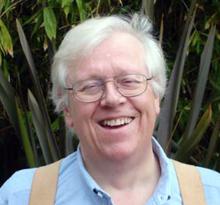


For our ancestors, misjudging the physical strength of a would-be opponent might have resulted in painful –– and potentially deadly –– defeat.
Now, a study conducted by a team of scientists at UC Santa Barbara has found that a mechanism exists within the human brain that enables both men and women to determine the strength and fighting ability of men around them simply by hearing their voices. A paper highlighting the researchers' findings appears in the current issue of the Proceedings of the Royal Society B.
The current research is part of a larger study examining the neurocognitive architecture in the human brain that recognizes and assesses physical strength and fighting ability. "People are well-designed to assess fighting ability," said Aaron Sell, a postdoctoral fellow at UCSB's Center for Evolutionary Psychology and the paper's lead author. "Our previous research shows how the mind uses visual cues to assess fighting ability. But now we have evidence that fighting ability can be detected through the voice. It is part of a complex system that natural selection designed to help our ancestors size up their opponents."
Sell conducted the study with Greg Bryant, assistant professor of communications at UCLA; Leda Cosmides, professor of psychology and co-director of UCSB's Center for Evolutionary Psychology; John Tooby, professor of anthropology and also co-director of the Center for Evolutionary Psychology; Michael Gurven, associate professor of anthropology; graduate students Daniel Sznycer and Christopher von Rueden; and Andre Krauss, a professor at the University of Timisoara in Romania.
"Ancestrally, there would have been many occasions when the assessment of fighting ability from visual cues would be hampered," continued Sell. "Such conditions, if sufficiently recurrent, would have selected for supplementary assessment systems that did not rely on sight. Moreover, the voice conveys many different kinds of information relevant to conflict that are largely absent from a visual inspection of the body."
The researchers took voice samples and body and strength measurements from four distinct populations, including Tsimane hunter-horticulturalists of Bolivia, Andean herder-horticulturists of Argentina, and college students in the United States and in Romania. A group of undergraduate students from UCSB were then instructed to rate the voices on physical strength, fighting ability, height, and weight, using a seven-point scale. Their ratings were then evaluated against the body and strength measurements.
Regardless of whether respondents were asked to assess height, weight, strength, or fighting ability, they produced similar ratings that tracked upper body strength more than height and weight. Amazingly, respondents demonstrated the same degree of accuracy with unfamiliar languages and cultures as they did with their own. This study provides the first direct evidence that both men and women can accurately assess men's physical strength from the voice, and suggests that estimates of strength are used to assess fighting ability.
"We also learned that combining visual cues with voice cues offers a better predictor of actual strength than either one by itself," said Sell. "If you're looking at a guy with his shirt off, you can estimate his strength pretty well; if you can hear his voice as well, you'll get an even more accurate assessment of his strength. That means the voice contains some cues of strength that are invisible to the eye."
"You might think that experience –– that is, a general ability to detect and learn correlations –– drives these findings," said Tooby. "That would predict that the mind would be just as good or better at detecting height or weight from the voice as strength and fighting ability.
After all, height and weight are far more perceptually apparent than strength or fighting ability.
But that's not what we find.
Whether you ask subjects to judge height, weight, fighting ability, or strength from the voice, their judgments correlate best with the speaker's actual upper body strength.
Ancestrally, that's what the mind needed to know, and so that's what this specialized mechanism hears in the voice."
Moreover, Cosmides pointed out, "men have a lot more experience with rough and tumble play and with fighting, but women were just as good at assessing these variables."
Indeed, the researchers suggest that the ability to judge physical strength and fighting ability evolved to serve important functions for both men and women. In men, the mechanism is a barometer for measuring potential threats and determining how aggressive or deferential they should be when facing a competitor. For women, men's strength also plays a significant role in their mating psychology.
The authors also point out that neither men nor women fare as well in using voice cues to assess women's strength and fighting ability. This is expected from an evolutionary perspective because anthropological evidence shows that, ancestrally, inflicting violence was mostly the province of men.
The findings also answer a 30-year question in perceptual psychology regarding why studies examining the ability to assess height and weight from the voice have had inconsistent results. Since the 1960's, 16 separate published studies have looked at whether people can assess height and weight from the voice. The findings were split down the middle.
Noted Sell: "The problem is that they were looking at the wrong variables.
Our research confirms that height and weight assessment is inconsistent." In contrast, fighting ability and its single largest component –– upper body strength –– were more important to our ancestors, than height or body size per se. As a result, natural selection constructed a brain specialization designed to use multiple cues to assess upper body strength, and upper body strength to assess fighting ability.
"We find across all the eight samples and across all four languages and cultures that ratings track physical strength very well," he said.
Related Links
Proceedings of the Royal Society B
Center for Evolutionary Psychology



